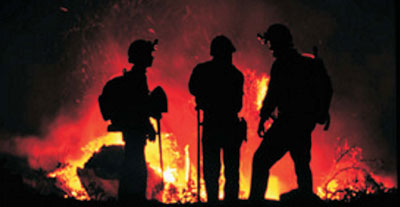Fire suppression is an inherently dangerous job and very hazardous. No
resource or facility is worth the loss of human life; however while working
within their agency doctrine and policy, fire fighters using the best
available science, equipment, and training can be killed or injured. Our
employees are expected to make reasonable and prudent decisions to accomplish
the agency mission while minimizing loss of life and serious injuries.
Fire fighters are empowered and expected to manage the risks of fire suppression.
The purpose of risk management is to minimize the exposure and affects
of the inherent hazards in fire suppression while maximizing the opportunities
to achieve mission objectives during fire suppression operations. Risk
management includes communications and a process for situational awareness,
hazard assessment, hazard control, decision point and evaluation.
—Safety is the ability fire fighters have to deal with risks
or hazards to avoid damage or losses and yet still achieve the leader's
intent,
—Risk management is a dynamic process exercised by everyone having
fire suppression responsibilities or duties. It allows individuals to
assess a given situation and take what they determine is the most appropriate
course of action based on leaders' intent,
—We recognize and accept the inherent risks associated with fire
suppression. We depend on our doctrine, training, skilled experience,
and leadership to mitigate those risks. Disregard for these recognized
inherent risks and failure to practice risk management is unacceptable,
regardless of whether or not it results in injury or death.
—Individuals will be held accountable for their decisions. Those
decisions should be considered to be reasonable and prudent based on
doctrine, training, and experience given the context of the situation.
—In order to mitigate effects of fatigue of mind and body, it
is a fire suppression leadership responsibility, as well as a personal
responsibility to appropriately manage fatigue.
—To promote a bias for action fire fighters are expected to maximize
suppression opportunities while minimizing exposure to inherent risks.
—Organizational learning is crucial to risk management. Fire
fighters are students of fire and continually learn from all situations
including successes, failures, agency safety investigations, and reviews.
We foster an atmosphere of willful communication. Therefore it’s
critical that employee statements for agency safety investigations are
treated as “confidential”.
—Extensive formal and informal training is critical to risk management
and mission accomplishment.
—Fire suppression leadership ensures all employees with an incident
qualifications card adhere to and maintain an appropriate level of physical
fitness.
—Recognize those practicing and promoting the use of risk management
in the accomplishing the agency mission.

